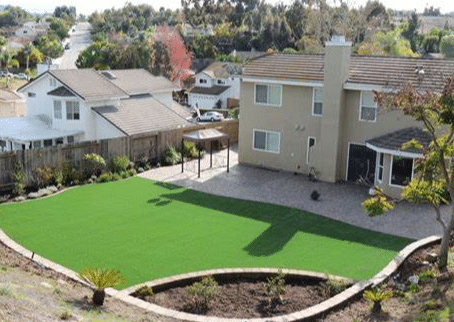What Are Important Steps To Install Artificial Grass In Spring Valley?

- Measure your area carefully and calculate how many square feet of grass you need to cover it. This will help you determine how much turf to buy for your project.
- Once you have measured the space, clear out any debris or rocks and level off any bumps or dips in the ground – this will ensure a more even surface for your turf installation.
- It’s important to lay down a weed barrier before you begin laying the grass. This will help prevent roots and weeds from breaking through the turf and creating an uneven surface.
- Once your weed barrier is in place, spread a thin layer of crushed rock over it. This will serve as drainage for the artificial grass and ensure that water can easily travel through it.
- Now it’s time to roll out your artificial grass! Make sure to unroll it evenly across the area and use landscape staples every few feet along each side of the turf to hold it in place.
- You may need to trim or cut your turf in order to fit it around any obstacles in your yard like flower beds, trees, or rocks. Use a sharp utility knife and straight edge for clean edges.
- Once you’ve trimmed your artificial grass, spread an infill product over the top of it to help keep it secure and add support for its weight. This will also help prevent weeds from growing underneath it and causing an uneven surface.
FAQ’s
What Is The Process To Install Artificial Grass?
The process of installing artificial grass consists of measuring and calculating the amount of turf needed, clearing and leveling the area, laying a weed barrier, adding a base layer of crushed rock, rolling out the turf and trimming it to fit around obstacles in your yard. Lastly, you will need to infill the artificial grass with an infill product.
How To Lay Artificial Grass In Your Yard?
Laying artificial grass in your yard can be a great way to achieve a lush, green lawn without the maintenance and upkeep associated with natural grass. Start by measuring the area where you want to lay the artificial grass. Remove any existing grass, weeds, or debris from the area. Ensure the ground is level and compacted. Lay a weed barrier fabric over the prepared area. This will help prevent weeds from growing through the artificial grass. Trim the excess fabric and secure it in place with landscape staples. Spread a layer of crushed rock or sharp sand over the weed barrier. This will provide a stable base for the artificial grass and aid with drainage. Use a rake to spread and level the base material. Use a plate compactor or a hand tamper to compact the base material. This will create a solid and level surface for the artificial grass. Make sure the base is evenly compacted. Roll out the artificial grass over the compacted base. Allow the grass to acclimate to the surroundings for a few hours to remove any creases. Trim any excess grass using a utility knife. Make sure the grass fibers are facing the same direction for a uniform look. If your yard requires multiple rolls of artificial grass, you’ll need to join the seams. Use adhesive or specialized joining tape to secure the seams together. Follow the manufacturer’s instructions for the specific product you’re using. Use landscape staples or galvanized nails to secure the edges of the artificial grass. Place them approximately every 6-8 inches along the perimeter. This will help hold the grass in place and prevent it from shifting. Some types of artificial grass require infill to enhance stability and provide cushioning. If your grass requires infill, spread it evenly over the surface and brush it into the fibers using a stiff broom. After installation, brush the artificial grass with a stiff broom to help the fibers stand upright. Regularly remove leaves, debris, and pet waste to keep the grass clean. Rinse the grass occasionally to remove dust and maintain its appearance.
What Kind Of Infill Is Used For Artificial Grass?
Silica sand or rubberized crumb are both popular types of infill used for artificial grass installations. They help provide support for the turf’s weight as well as prevent weeds from growing underneath it.
What Preparation Is Needed For Artificial Grass?
Before you begin installing your artificial grass, you need to measure the area and calculate how much turf is needed. You should also clear out any debris or rocks and level off any bumps or dips in the ground. Finally, it’s important to lay down a weed barrier before you begin laying the grass.
Conclusion
It is important to take the time to carefully plan and execute your artificial grass installation in order to get the best results. By following these seven steps, you can ensure a successful project that will provide you with a lush, green lawn for years to come. For more information, contact Artificial Grass Spring Valley at (619) 304-0080.